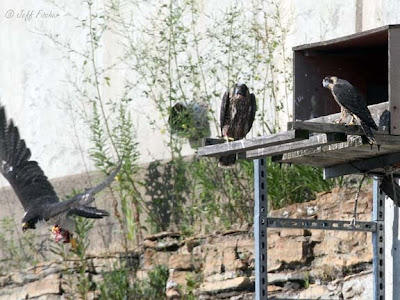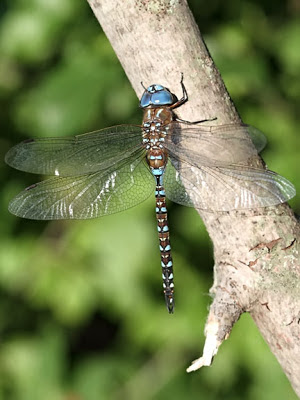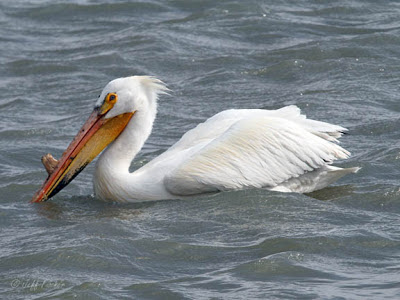The Cooper's hawk population here in the Twin Cities has been growing over the past 10 years or so. Last year they were the species that was emitted the most into the clinic at The Raptor Center. The most accepted theory about their increase in population is the increase of people feeding birds at feeders. Bird feeders are like a buffet for the Cooper's Hawk. This food source is especially important during the winter. Most birds do not migrate because of cold. They migrate because of a lack of food during the cold winter. As there are more bird feeders out, there is more food available during the winter. So more song birds stick around instead of heading south. The more song birds that stick around over the winter the more food available to the Cooper's hawk. So more Coops hang around during the winter instead of heading south.
Tuesday, July 30, 2013
Cooper's Hawk
Labels:
ABC Wednesday,
coopers hawk,
Wild Bird Wednesday
Saturday, July 27, 2013
Merlin Falcon
The merlin is a falcon that is found in the Northern Hemisphere. They breed in the northern portions of their territory, Canada, Alaska, Siberia, the Netherlands and such. They winter in the southern US, Mexico, Central America, Northern South America, the Baltic Countries, Northern Africa, the Middle East, and China. Here in southern Minnesota we have a few nesting pairs that are found in the Twin Cities. Merlin's do not build their own nest but take over the nest of another raptor or more typically a crow. They are much more prevalent in the northern part of the state like up in Duluth.
Friday, July 26, 2013
Tuesday, July 23, 2013
Monday, July 22, 2013
Black-throated Green Warbler
The black-throated green warbler is a wood warbler that is found in the eastern half of North America. They breed primarily in the boreal and coniferous forests of eastern Canada, although there is an Appalachian subspecies that breed in the cypress swamps of Virginia, North and South Carolina. Black-throated green warbles feed on insects and their larva which they glean from leaves and small branches. In the winter they migrate to southern Florida, Mexico, the Caribbean, Central America and northern parts of South America.
Sunday, July 21, 2013
Teneral Dragonfly
I went out to Crex Meadows yesterday hoping to get some video of butterflies for an upcoming program I am doing. While I out checking the butterfly weed I found this teneral dragonfly perched on the flower. Dragonflies are predators, they do not eat nectar or pollen like butterflies, however when they first emerge from their larval stage they are vulnerable and usually find an out of the way place to perch while their wings firm. I would guess that this is some kind of meadowhawk but teneral dragonflies are often hard to identify because they usually have not developed their field markings yet. With its orangish coloration the butterfly weed was a good place to perch because it blended in nicely.
Friday, July 19, 2013
Thursday, July 18, 2013
Tuesday, July 16, 2013
American Avocet
Labels:
ABC Wednesday,
American Avocet,
Wild Bird Wednesday
Monday, July 15, 2013
Peregrine Nest Box at the Ford Dam
Like most areas east of the Mississippi the peregrine falcon population was wiped out by DDT. DDT was a chemical insecticide that was originally used to kill mosquitoes that were spreading malaria back in the 1950's. Once Malaria was no longer a threat in the US DDT was used as an insecticide on crops. The DDT did not affect the adult birds, instead it made their egg shells very thin. So when the peregrines were incubating the eggs they would break and so there were very few birds that were being hatched. By the time DDT was banned in 1972 there were very few falcons left in the eastern half of the continent. In the 1980's the Midwest Peregrine Fund began releasing peregrine chicks that they procured from falconers in Minnesota. Initially they tried to release them in the cliff areas of the southern Mississippi River Valley. When that did not work they began to release them from sky scrapers. The release programs worked so well that the peregrine falcon was removed from the endangered species list in 1999. Here in Minnesota we actually have more nesting pair then we did prior to DDT because we created a variety of man-made nesting locations ( buildings, bridges, smoke stacks ) that increased the amount of nesting territories in the state.
One of the best nesting spots for people to actually view the young falcons is at Dam Number 1, often referred to as the Ford Dam. The nesting box is not much higher then the observation platform for the dam which gives falcon watchers a birds eye view. Today while I watched the two chicks in the nest were not very hungry so mom decided to take the food and eat it herself. Shortly later the male falcon made an error coming out of the box and he missed the perch and ended up on a ledge below. Fortunately he did not appear to be hurt. He is away from predators and the parents will keep an eye on him and feed him on the ledge but there is very little shade. Hopefully he will be flying soon and will be better off for this ittle adventure.
Sunday, July 14, 2013
Blue Bells
The blue bell is a plant that is native to western Europe, particularly the British Isles. It has spread to North America where it is now found in the northwest and northeastern United States. I photographed this flower in Yellowstone where it was one of the few species of wild flowers that was already in bloom at the end of May.
Saturday, July 13, 2013
Northern Flicker
The northern flicker is a large woodpecker found across most of North America. They breed through out the US, Alaska and Canada but those in the northern portion of the range migrate south for the winter. They are often found foraging on the ground. They use their beak to dig up insects, particularly ants, and then slurp them up with their long barbed tongue. Northern flickers in the eastern half of North America show yellow under their wings and on the underside of the tail. They are called yellow shafted. Red-shafted northern flickers, like the one above, show red below the wings and tail and are found in the western half. At one time these were two distinct species but now they are considered one, mainly because they hybridize with each other in the middle of the continent.
Friday, July 12, 2013
Thursday, July 11, 2013
Wednesday, July 10, 2013
Tuesday, July 9, 2013
Zonotrichia leucophrys (white-crowned sparrow)
The white crowned sparrow is a common Emberizine sparrow that is found throughout all of North America. These birds nest in Northern Canada as well as the Rocky Mountain region. They winter in the southern US and Mexico. For those of us here in Minnesota we usually only see them in the sprint and fall when they migrate. I photographed this bird in Yellowstone. This is nesting territory and since there were quite a few singing in the open fields I am guessing it was time to find a mate and settle down.
Monday, July 8, 2013
Tower Falls
On the northeast side of Yellowstone National Park, Tower Creak plunges 132 feet on its way to converge with the Yellowstone River. Tower Falls was named by Samuel Hauser, a member of the Washburn Expedition, in 1870. He named it Tower Falls after the rock pinnacles that surround the top of the falls.
Sunday, July 7, 2013
Blue-eyed Darner
The blue-eyed darner is a large dragonfly that is typically found in the western US down into Central America. Until the past few years there were very few records of this species in Minnesota and those were all in the southeast corner of the state. It is possible that this was because the state was very poorly surveyed until the Minnesota Odonata Survey began several years ago. In the past few years sightings in Minnesota suggest that there range may be more extensive then first thought. It is also possible that there range has expanded or changed due to climate change. This theory is made more possible by the large number of sightings last year, when we had an unusually mild winter and early spring. This year has been quite the opposite, weather wise, and I have not heard of any sightings of this species in Minnesota so far this year.
Saturday, July 6, 2013
Friday, July 5, 2013
Subscribe to:
Posts (Atom)



















































